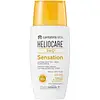What's inside
What's inside
 Key Ingredients
Key Ingredients

 Benefits
Benefits

 Concerns
Concerns

 Ingredients Side-by-side
Ingredients Side-by-side

Isododecane
EmollientDimethicone
EmollientPropylene Glycol
HumectantButylene Glycol
HumectantVinyldimethicone
Diethylamino Hydroxybenzoyl Hexyl Benzoate
UV FilterMethyl Salicylate
PerfumingNeopentyl Glycol Diheptanoate
EmollientBis-Ethylhexyloxyphenol Methoxyphenyl Triazine
Skin ConditioningVp/Hexadecene Copolymer
Silica Dimethyl Silylate
EmollientGlycerin
HumectantMethyl Methacrylate Crosspolymer
Alcohol
AntimicrobialZinc Oxide
Cosmetic ColorantLauryl PEG-9 Polydimethylsiloxyethyl Dimethicone
Skin ConditioningTrimethylsiloxysilicate
EmollientPolypodium Leucotomos Leaf Extract
Skin ProtectingC12-15 Alkyl Benzoate
AntimicrobialTitanium Dioxide
Cosmetic Colorant1,2-Hexanediol
Skin ConditioningHydroxyacetophenone
AntioxidantFructose
HumectantDisteardimonium Hectorite
StabilisingParfum
MaskingPanthenol
Skin ConditioningPolyhydroxystearic Acid
EmulsifyingTocopheryl Acetate
AntioxidantIsohexadecane
EmollientBisabolol
MaskingDimethiconol
EmollientSilica
AbrasiveAlumina
AbrasiveStearic Acid
CleansingTriethoxycaprylylsilane
Sodium Polyglutamate
HumectantHydroxyphenyl Propamidobenzoic Acid
Skin ConditioningZingiber Officinale Root Extract
MaskingTocopherol
AntioxidantAlpha-Isomethyl Ionone
PerfumingCitronellol
PerfumingCitrus Aurantium Amara Peel Oil
Skin ConditioningHexyl Cinnamal
PerfumingLimonene
PerfumingLinalool
PerfumingLinalyl Acetate
MaskingTetramethyl Acetyloctahydronaphthalenes
MaskingIsododecane, Dimethicone, Propylene Glycol, Butylene Glycol, Vinyldimethicone, Diethylamino Hydroxybenzoyl Hexyl Benzoate, Methyl Salicylate, Neopentyl Glycol Diheptanoate, Bis-Ethylhexyloxyphenol Methoxyphenyl Triazine, Vp/Hexadecene Copolymer, Silica Dimethyl Silylate, Glycerin, Methyl Methacrylate Crosspolymer, Alcohol, Zinc Oxide, Lauryl PEG-9 Polydimethylsiloxyethyl Dimethicone, Trimethylsiloxysilicate, Polypodium Leucotomos Leaf Extract, C12-15 Alkyl Benzoate, Titanium Dioxide, 1,2-Hexanediol, Hydroxyacetophenone, Fructose, Disteardimonium Hectorite, Parfum, Panthenol, Polyhydroxystearic Acid, Tocopheryl Acetate, Isohexadecane, Bisabolol, Dimethiconol, Silica, Alumina, Stearic Acid, Triethoxycaprylylsilane, Sodium Polyglutamate, Hydroxyphenyl Propamidobenzoic Acid, Zingiber Officinale Root Extract, Tocopherol, Alpha-Isomethyl Ionone, Citronellol, Citrus Aurantium Amara Peel Oil, Hexyl Cinnamal, Limonene, Linalool, Linalyl Acetate, Tetramethyl Acetyloctahydronaphthalenes
Water
Skin ConditioningDicaprylyl Carbonate
EmollientEthylhexyl Methoxycinnamate
UV AbsorberPropanediol
SolventDibutyl Adipate
EmollientButyl Methoxydibenzoylmethane
UV AbsorberEthylhexyl Triazone
UV AbsorberBis-Ethylhexyloxyphenol Methoxyphenyl Triazine
Skin ConditioningC20-22 Alkyl Phosphate
EmulsifyingC20-22 Alcohols
Emulsion StabilisingBenzotriazolyl Dodecyl P-Cresol
UV AbsorberSodium Hyaluronate
HumectantCarnosine
Skin ConditioningTocopherol
AntioxidantCaprylyl/Capryl Glucoside
Cleansing1,2-Hexanediol
Skin ConditioningXanthan Gum
EmulsifyingParfum
MaskingPolyacrylate Crosspolymer-6
Emulsion StabilisingBHT
AntioxidantSodium Hydroxide
BufferingO-Cymen-5-Ol
AntimicrobialCitric Acid
BufferingWater, Dicaprylyl Carbonate, Ethylhexyl Methoxycinnamate, Propanediol, Dibutyl Adipate, Butyl Methoxydibenzoylmethane, Ethylhexyl Triazone, Bis-Ethylhexyloxyphenol Methoxyphenyl Triazine, C20-22 Alkyl Phosphate, C20-22 Alcohols, Benzotriazolyl Dodecyl P-Cresol, Sodium Hyaluronate, Carnosine, Tocopherol, Caprylyl/Capryl Glucoside, 1,2-Hexanediol, Xanthan Gum, Parfum, Polyacrylate Crosspolymer-6, BHT, Sodium Hydroxide, O-Cymen-5-Ol, Citric Acid
 Reviews
Reviews

Ingredients Explained
These ingredients are found in both products.
Ingredients higher up in an ingredient list are typically present in a larger amount.
1,2-Hexanediol is a synthetic liquid and another multi-functional powerhouse.
It is a:
- Humectant, drawing moisture into the skin
- Emollient, helping to soften skin
- Solvent, dispersing and stabilizing formulas
- Preservative booster, enhancing the antimicrobial activity of other preservatives
You might know this ingredient as Tinosorb S or Bemotrizinol. It is a UV filter that covers both UVA and UVB rays.
This ingredient has two peak UV absorption peaks ( 310 and 340 nm) and is able to absorb both UV-A and UV-B rays. This ingredient works by preventing UV rays from reaching and damaging your skin.
On top of that - it is highly photostable and helps prevent the photodegration of other sunscreen ingredients such as avobenzone.
Tinosorb S is allowed in the EU, Australia, and Asia. It is close to being approved by the FDA and we'll hopefully get this ingredient in the U.S. by late 2025.
Fun fact: Tinosorb S is the most effective UV absorber at maximum concentration (measured by SPF) permitted in the EU.
This ingredient is oil-soluble, so your oil-cleansers will take this right off at night.
Learn more about Bis-Ethylhexyloxyphenol Methoxyphenyl TriazineParfum is a catch-all term for an ingredient or more that is used to give a scent to products.
Also called "fragrance", this ingredient can be a blend of hundreds of chemicals or plant oils. This means every product with "fragrance" or "parfum" in the ingredients list is a different mixture.
For instance, Habanolide is a proprietary trade name for a specific aroma chemical. When used as a fragrance ingredient in cosmetics, most aroma chemicals fall under the broad labeling category of “FRAGRANCE” or “PARFUM” according to EU and US regulations.
The term 'parfum' or 'fragrance' is not regulated in many countries. In many cases, it is up to the brand to define this term.
For instance, many brands choose to label themselves as "fragrance-free" because they are not using synthetic fragrances. However, their products may still contain ingredients such as essential oils that are considered a fragrance by INCI standards.
One example is Calendula flower extract. Calendula is an essential oil that still imparts a scent or 'fragrance'.
Depending on the blend, the ingredients in the mixture can cause allergies and sensitivities on the skin. Some ingredients that are known EU allergens include linalool and citronellol.
Parfum can also be used to mask or cover an unpleasant scent.
The bottom line is: not all fragrances/parfum/ingredients are created equally. If you are worried about fragrances, we recommend taking a closer look at an ingredient. And of course, we always recommend speaking with a professional.
Learn more about ParfumTocopherol (also known as Vitamin E) is a common antioxidant used to help protect the skin from free-radicals and strengthen the skin barrier. It's also fat soluble - this means our skin is great at absorbing it.
Vitamin E also helps keep your natural skin lipids healthy. Your lipid skin barrier naturally consists of lipids, ceramides, and fatty acids. Vitamin E offers extra protection for your skin’s lipid barrier, keeping your skin healthy and nourished.
Another benefit is a bit of UV protection. Vitamin E helps reduce the damage caused by UVB rays. (It should not replace your sunscreen). Combining it with Vitamin C can decrease sunburned cells and hyperpigmentation after UV exposure.
You might have noticed Vitamin E + C often paired together. This is because it is great at stabilizing Vitamin C. Using the two together helps increase the effectiveness of both ingredients.
There are often claims that Vitamin E can reduce/prevent scarring, but these claims haven't been confirmed by scientific research.
Learn more about Tocopherol